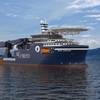As crude oil prices reach Gulf War highs and recent memories of historic low crude prices fade, capital spending on finding and developing new oil reserves continue to play catch up.
"The recent oil-price crisis set back non-OPEC output growth for at least a year," a recent report released by Deutsche Banc Alex. Brown states, adding, "While currently high oil prices should spur investment, the extensive 16-month price slide should delay any significant output response from non-OPEC producers."
Analysts say there is a lag time for exploration spending to play catch up with oil prices - for every one month when crude prices are below the cost of production, it takes three months of high prices to regain the volume of production lost during the low cost period.
Crude prices began to rebound from lows near $10 a barrel when OPEC and other major producers cut crude production to raise prices in March 1999.
But industrialized countries looking for more oil may have trouble finding it as the prolonged cuts have eaten into OPEC's spare production capacity, increasing the need for other countries and private companies to ramp up output.
Non-OPEC oil costs are generally higher than those within OPEC, and thrives when oil prices are high.
Exploration for oil outside of OPEC picked up in the late 1970s in order to counter dependence on the cartel's oil following oil price shocks in 1973 and 1979. The world depends on this group's production to meet about two-thirds of the current 75 million bpd of crude oil demand.
Although oil demand growing and crude oil prices have topped $33 a barrel, analysts say upstream spending still lags.
"Demand seems to be back on track (following the Asian economic crisis), especially with the U.S. economy continuing to surprise. But companies continue to approach upstream spending cautiously, choosing instead to reduce debt, buy back shares, and explore for natural gas." says Jay Saunders, energy analyst for Deutsche Banc.
"A lot of people assume there is a lot of shut in capacity, outside of OPEC. But apart from Mexico, everyone else is producing at capacity," Matthew Simmons of Simmons and Company International.
Fundamental Questions
From 2000 to 2003, Deutsche Banc Alex. Brown estimates that worldwide demand should grow some 6.5 million bpd, or 1.625 million bpd annually.
On the supply side, after five years of growth during which non-OPEC production rose by an average of around 770,000 bpd annually, 1999 saw output outside the cartel stay flat. This year, expectations are for a large gain, but not from new projects but from those put on hold last year.
"You'll still get nearly a million bpd from non-OPEC this year, but it's mostly from projects delayed from last year rather than new investment this year," Saunders says.
After this year, gains look to smaller. From 2000 to 2003, Deutsche Bank predicts non-OPEC production will rise by an average of 470,000 bpd annually.
Other analysts are significantly more bearish.
"I don't think its going to be very much (the increase in non-OPEC spending), maybe 200,000 bpd to 300,000 bpd for 2000," says Simmons, "You really won't have a good sense of this until the second and third quarter when North Sea fields begin doing their maintenance."
Getting more oil from OPEC to meet the growing demand is complicated by a lack the lack of spare production capacity as well as the conflicting desires within the group. Producers with less additional output capability tend to like a higher price as they cannot take advantage of higher quotas.
However, if a supply crunch began to drive oil prices too high, it would begin to cut into demand, analysts say.
High Costs, Small Growth
The search for stable oil supply sent companies out of areas with dwindling prospects such as the onshore United States, and into more exotic locations such as the North Sea and offshore West Africa and Brazil, where costs are high.
According to Simmons, in order to make developments in those areas economic, companies need fields to produce high volumes quickly. Such field management means that peak output will be much shorter, and declines much faster.
Stemming that decline and producing all possible oil from a field adds significant costs for companies. For some firms, this means spending more just to keep total company production flat.
Simmons says that during the period from 1996 to 1998, the 20 most efficient exploration and production companies in the world increased upstream spending by 50 percent, only to see production drop off by half a million barrels per day.
And this is one area where non-OPEC production felt the pinch - companies just have not been employing funds to curb field declines. For instance, infill drilling, one way to keep production from dropping these areas by spudding new wells between old ones, took a significant beating.
"The majority of fields offshore U.S., the U.K. and Norway depend on infill drilling to maintain the production or to avoid the drop out of about 15 percent a year which is the natural depletion (after peak production)," said the chief executive officer of one independent producer in the United Kingdom, who did not wish to be named.
"In periods of low oil prices like $10 or $12 (per barrel of oil) that we had last year, the majority of operators curtailed infill drilling or stopped it... and everyone has to be confident that the oil price range will be higher than 10 to 12 for a sustainable period and then you have to recommission rigs and hire crews and get all the partners to agree to restart drilling," he added.
In the meanwhile, all eyes are focusing on the international rig count as a bellwether for increased exploration and production.
"Oil doesn't just come out of the ground. Until the international rig count rises no one should be anticipating a surge in non-OPEC supply just because the price is high," said Simmons. - (Reuters)
Featured videos

Inside the Electrified Truckable Tug

Tracking Foreign Vessels Working in the U.S. Jones Act Market

Inmarsat Enhances Service to Drive Digitalization
Subscribe for
Maritime Reporter E-News
Maritime Reporter E-News is the maritime industry's largest circulation and most authoritative ENews Service, delivered to your Email five times per week









